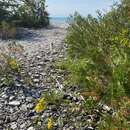en
names in breadcrumbs


Reports of Solidago houghtonii from New York have been rejected as being based on misidentified specimens (J. K. Morton 1979). Some collections have the large involucres typical of S. houghtonii; molecular data indicate that the species is present in Genessee County, New York (P. Laureto, pers. comm.).
Solidago houghtonii can be difficult to distinguish from S. ohioensis × S. ptarmicoides hybrids because both have hairy peduncles in arrays. The hybrids have pale yellow rays even when fresh; post-flowering rays of S. houghtonii can be pale yellow. J. K. Morton (1979) hypothesized an allopolyploid origin for the hexaploid S. houghtonii via an unreduced gamete of S. ohioensis × S. ptarmicoides backcrossed to S. ohioensis with subsequent chromosome doubling. Additional work is needed to confirm this hypothesis. An aberrant collection (M. R. Penskar 1067, MICH) had about 400 heads (mostly in bud) due to axillary branches developing along nearly the entire stem; stems usually have fewer than 50 heads. Some plants from Michigan are more robust than those found in Ontario.
Solidago houghtonii is listed by the U.S. Fish and Wildlife Service as threatened in Michigan. It is in the Center for Plant Conservation’s National Collection of Endangered Plants.
Solidago houghtonii is a rare North American species of flowering plant in the family Asteraceae known as Houghton's goldenrod. It is native to southern Ontario, Canada and the northern United States (Michigan and New York).[4] It is threatened by the loss and degradation of its habitat. It is a federally listed threatened species of the United States and it is designated a species of special concern by Canada's Committee on the Status of Endangered Wildlife in Canada.[2]
Solidago houghtonii is a perennial herb producing one or more erect stems up to 60 centimeters (2 feet) tall or more from a branching caudex covered with the remains of previous seasons' leaves. The leaves near the base of the plant are oval in shape and those higher on the stem are linear or lance-shaped and up to 17 or 18 centimeters (6.8-7.2 inches) in length. The inflorescence is an array of many flower heads each up to a centimeter long. The head contains 6 to 12 yellow ray florets surrounding several disc florets. The fruit is about half a centimeter (0.2 inches) long including the pappus of bristles at the tip.[5] Blooming occurs in August.[2]
Houghton's goldenrod was originally described by John Torrey and Asa Gray in 1848 as Solidago houghtonii. In 1993, Guy Nesom transferred it to the genus of flat-topped goldenrods, Oligoneuron.[6] This goldenrod is now treated by some sources as Oligoneuron houghtonii[7] and by others as Solidago houghtonii,[8][5][9][10] within the section Solidago sect. Ptarmicoidei.[11]
The name honors Douglass Houghton (1809–1845), a doctor, botanist, geologist, and civic leader who discovered this species in 1839 in Mackinac County, Michigan, on the shores of Lake Michigan.[12]
Solidago houghtonii grows on the shores of the Great Lakes, mainly Lake Huron and Lake Michigan, near the Michigan-Ontario border at Sault Ste. Marie.[5] It grows in sandy lakeshore habitat types as well as moist limestone alvars. The habitat is sometimes submerged but the plants return when water levels drop.[13] It also occurs in bog habitat.[2]
Houghton's goldenrod is threatened by the loss, degradation, and fragmentation of its habitat during development and construction. Any disturbance of the dunes among which the plant grows can be harmful. The use of off-road vehicles in the habitat is detrimental, and the installation of walls, roads, and other structures affects the dunes. Maintenance activities such as herbicide application, mowing, and road salting are threats, as is beach recreation.[2] Since 1975 about 20% of the populations of this plant have been eliminated.[2]
Solidago houghtonii is a rare North American species of flowering plant in the family Asteraceae known as Houghton's goldenrod. It is native to southern Ontario, Canada and the northern United States (Michigan and New York). It is threatened by the loss and degradation of its habitat. It is a federally listed threatened species of the United States and it is designated a species of special concern by Canada's Committee on the Status of Endangered Wildlife in Canada.